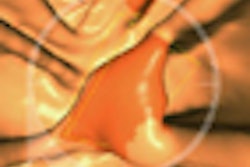
NEW YORK (Reuters Health), Jan 7 - Only about half of small abdominal aortic aneurysms (AAA) will increase in size, and those that grow less than 1.5 mm per year are seldom of clinical relevance, new research suggests.
The findings, based on 25 years of aneurysm surveillance in the UK, indicate that at baseline, small AAA display a unimodal distribution in size. However, after a few years of follow-up, the distribution becomes bimodal.
The results suggest that half of small AAA remain "quiescent with little growth," while the others continue to expand, senior author Dr. H. Hafez, from Western Sussex Hospital NHS Trust, Chichester and colleagues note in the British Journal of Surgery for January.
In the Chichester AAA screening program, data from 1,649 subjects with an AAA were collected prospectively from 1984 to 2007. In the 1,231 participants who had more than one ultrasound study and surveillance of more than three months, the median AAA diameter at baseline was 35 mm and the median growth over 3.2 years of follow-up was 9 mm.
Aneurysms ruptured in 88 patients and were electively repaired in 335, the report indicates. The median growth rates in patients who had rupture or surgery were 2.85 and 2.99 mm/year, respectively. By contrast, in subjects who were followed uneventfully, the aneurysms grew at a median rate of just 1.08 mm/year (p < 0.001).
Current smoking was associated with an increased AAA growth rate, whereas female gender and diabetes were linked to decreased growth rates. Age, mean arterial pressure, hypertension, ischemic heart disease, and use of ACE inhibitors or statins did not affect the growth rate.
"This study suggests that it may be possible to predict the likelihood of future clinical events based on the pattern of AAA growth," Dr. A. Nasim, from Leicester Royal Infirmary, UK, writes in an accompanying editorial. "This, combined with the fact that only 27.2% of the cohort ended up requiring AAA repair during follow-up, offers significant potential, as the authors suggest, for improving the cost-effectiveness of AAA screening and surveillance."
Br J Surg 2010;97:37-44.
Last Updated: 2010-01-06 12:44:57 -0400 (Reuters Health)
Related Reading
Endovascular AAA repair cuts short-term risk, October 13, 2009
Boom in endovascular AAA repair is appropriate, study suggests, July 6, 2009
Screening men for abdominal aortic aneurysm saves lives, but is it cost-effective? June 26, 2009
VC/AAA screening combo cost-effective in older adults, March 26, 2009
Study: Endovascular repair can come first for AAA, March 12, 2009
Copyright © 2010 Reuters Limited. All rights reserved. Republication or redistribution of Reuters content, including by framing or similar means, is expressly prohibited without the prior written consent of Reuters. Reuters shall not be liable for any errors or delays in the content, or for any actions taken in reliance thereon. Reuters and the Reuters sphere logo are registered trademarks and trademarks of the Reuters group of companies around the world.


















